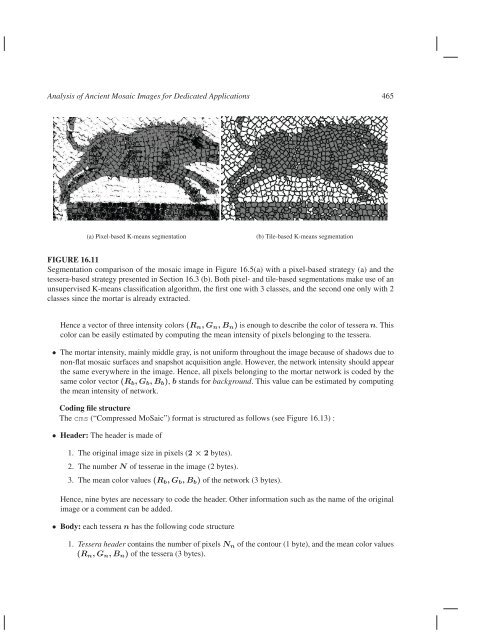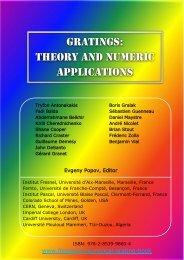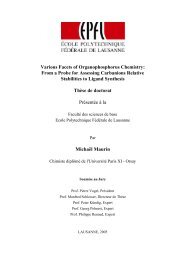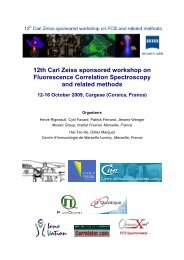Analysis of Ancient Mosaic Images for Dedicated ... - Institut Fresnel
Analysis of Ancient Mosaic Images for Dedicated ... - Institut Fresnel
Analysis of Ancient Mosaic Images for Dedicated ... - Institut Fresnel
You also want an ePaper? Increase the reach of your titles
YUMPU automatically turns print PDFs into web optimized ePapers that Google loves.
<strong>Analysis</strong> <strong>of</strong> <strong>Ancient</strong> <strong>Mosaic</strong> <strong>Images</strong> <strong>for</strong> <strong>Dedicated</strong> Applications 465<br />
(a) Pixel-based K-means segmentation (b) Tile-based K-means segmentation<br />
FIGURE 16.11<br />
Segmentation comparison <strong>of</strong> the mosaic image in Figure 16.5(a) with a pixel-based strategy (a) and the<br />
tessera-based strategy presented in Section 16.3 (b). Both pixel- and tile-based segmentations make use <strong>of</strong> an<br />
unsupervised K-means classification algorithm, the first one with 3 classes, and the second one only with 2<br />
classes since the mortar is already extracted.<br />
Hence a vector <strong>of</strong> three intensity colors (Rn, Gn, Bn) is enough to describe the color <strong>of</strong> tessera n. This<br />
color can be easily estimated by computing the mean intensity <strong>of</strong> pixels belonging to the tessera.<br />
• The mortar intensity, mainly middle gray, is not uni<strong>for</strong>m throughout the image because <strong>of</strong> shadows due to<br />
non-flat mosaic surfaces and snapshot acquisition angle. However, the network intensity should appear<br />
the same everywhere in the image. Hence, all pixels belonging to the mortar network is coded by the<br />
same color vector (Rb, Gb, Bb), b stands <strong>for</strong> background. This value can be estimated by computing<br />
the mean intensity <strong>of</strong> network.<br />
Coding file structure<br />
Thecms (“Compressed MoSaic”) <strong>for</strong>mat is structured as follows (see Figure 16.13) :<br />
• Header: The header is made <strong>of</strong><br />
1. The original image size in pixels (2 × 2 bytes).<br />
2. The number N <strong>of</strong> tesserae in the image (2 bytes).<br />
3. The mean color values (Rb, Gb, Bb) <strong>of</strong> the network (3 bytes).<br />
Hence, nine bytes are necessary to code the header. Other in<strong>for</strong>mation such as the name <strong>of</strong> the original<br />
image or a comment can be added.<br />
• Body: each tessera n has the following code structure<br />
1. Tessera header contains the number <strong>of</strong> pixels Nn <strong>of</strong> the contour (1 byte), and the mean color values<br />
(Rn, Gn, Bn) <strong>of</strong> the tessera (3 bytes).













